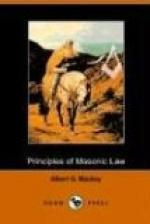Book First
The Law of Grand Lodges.
It is proposed in this Book, first to present the reader with a brief historical sketch of the rise and progress of the system of Grand Lodges; and then to explain, in the subsequent sections, the mode in which such bodies are originally organized, who constitute their officers and members, and what are their acknowledged prerogatives.
Chapter I.
Historical Sketch.
Grand Lodges under their present organization, are, in respect to the antiquity of the Order, of a comparatively modern date. We hear of no such bodies in the earlier ages of the institution. Tradition informs us, that originally it was governed by the despotic authority of a few chiefs. At the building of the temple, we have reason to believe that King Solomon exercised an unlimited and irresponsible control over the craft, although a tradition (not, however, of undoubted authority) says that he was assisted in his government by the counsel of twelve superintendants, selected from the twelve tribes of Israel. But we know too little, from authentic materials, of the precise system adopted at that remote period, to enable us to make any historical deductions on the subject.
The first historical notice that we have of the formation of a supreme controlling body of the fraternity, is in the “Gothic Constitutions"[4] which assert that, in the year 287, St. Alban, the protomartyr of England, who was a zealous patron of the craft, obtained from Carausius, the British Emperor, “a charter for the Masons to hold a general council, and gave it the name of assembly.” The record further states, that St. Alban attended the meeting and assisted in making Masons, giving them “good charges and regulations.” We know not, however, whether this assembly ever met again; and if it did, for how many years it continued to exist. The subsequent history of Freemasonry is entirely silent on the subject.




